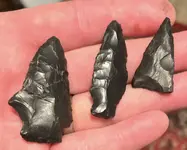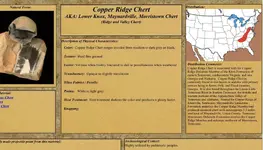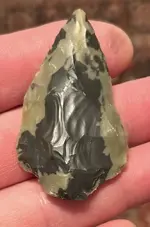Smoky Hill Silicified Chalk
Out here in the Central Great Plains one of the predominant chert sources is called Smoky Hill Silicified Chalk which is oftentimes shortened to “
Smoky Hill jasper”. This lithic source is found in the upper layer of the Smoky Hill chalk member of the Niobrara Formation. The Niobrara Formation is within the Cretaceous geologic time period. It is also known by other names including Niobrara jasper, Republican River jasper, Graham jasper and several others.
The below exhibit is one of several I made up to show materials specifically from the Smoky Hill jasper sources.
View attachment 2152673
Additional notes concerning the above exhibit:
1. The upper left hand corner basically demonstrates the fact that Smoky Hill chert
was utilized by all Central Plains cultures from Paleo to Late Prehistoric.
2. Upper right hand corner shows the color range of Smoky Hill but it is not all
inclusive, there are other variations.
3. Bottom left corner provides examples showing the different patinas Smoky Hill chert can
acquire with the coal black patina being the most dramatic change in surface coloration.
4. Bottom right hand corner provides examples of banded Smoky Hill chert which is oftentimes
confused with petrified wood.
View attachment 2152675
Artifacts made from Smoky Hill Silicified Chalk. The black piece exhibits a deep black patina which is sometimes observed on river found pieces.
View attachment 2152676
Two Large bifaces of Smoky Hill. I might add that in it raw form it is usually found in tabular lenses.






